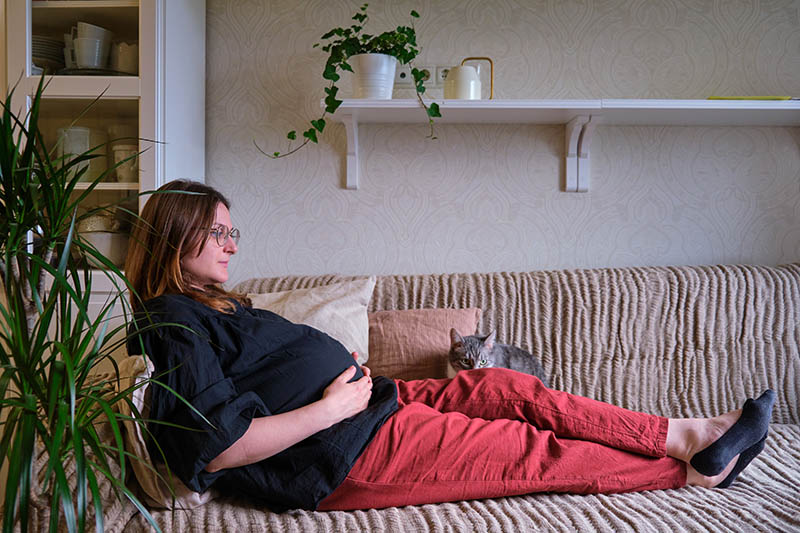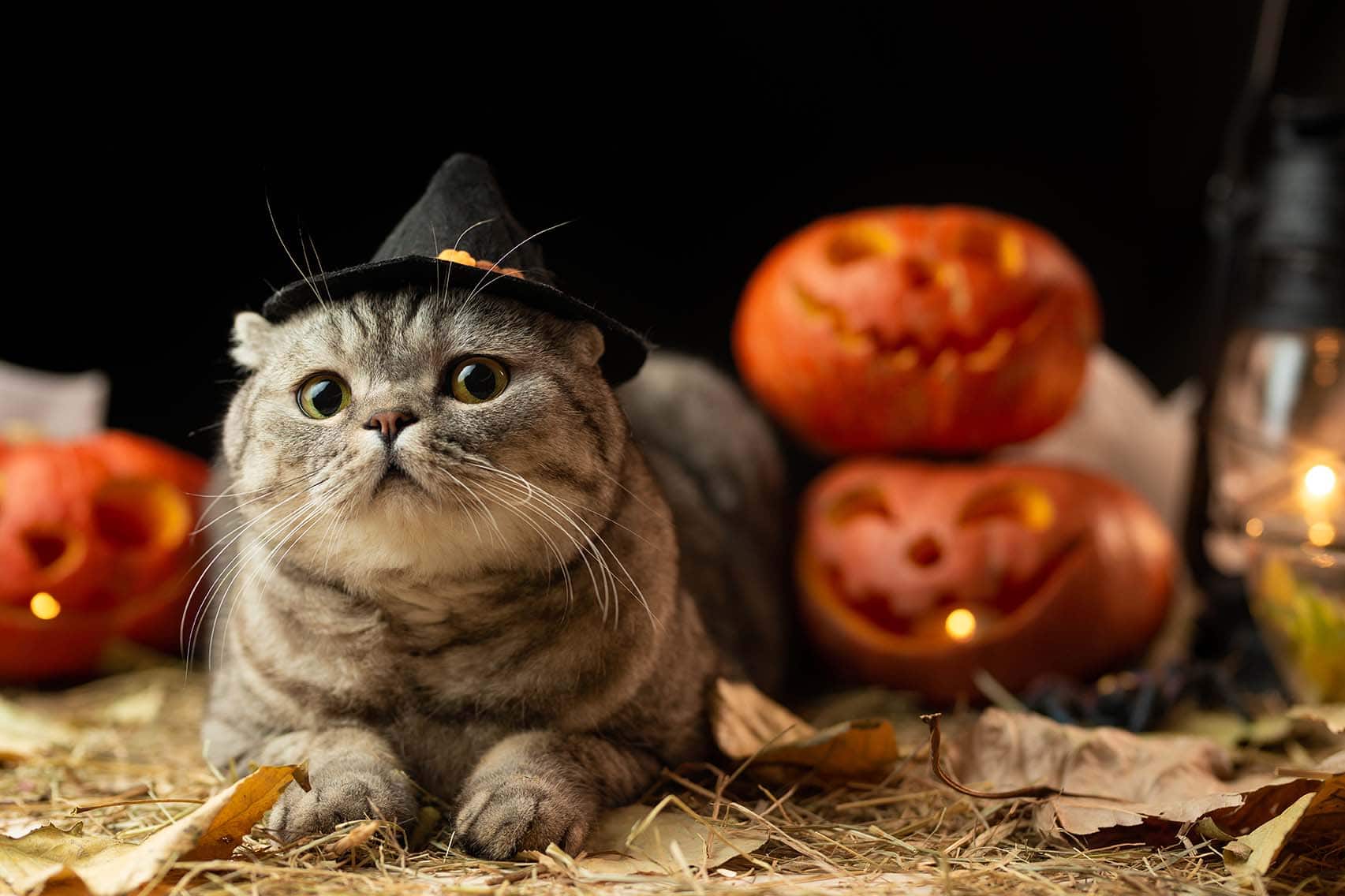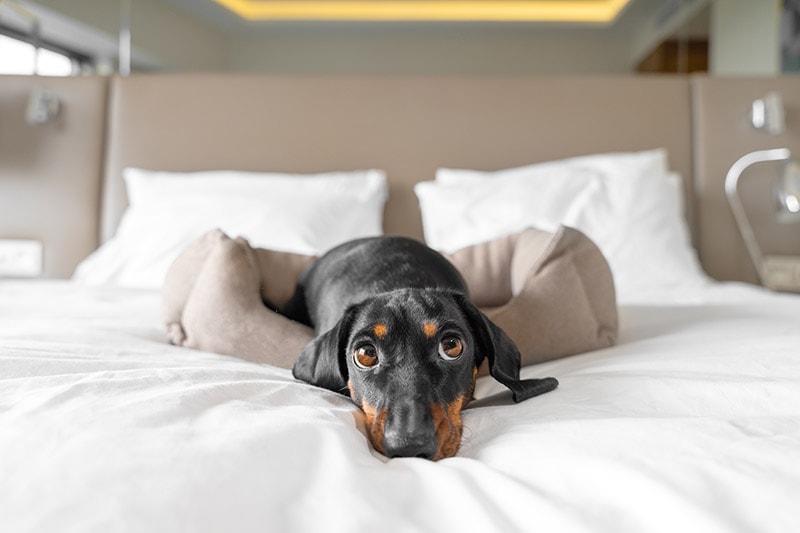What Temperature Is Too Hot for My Cat? Vet Reviewed Facts
By Ashley Bates
Updated on
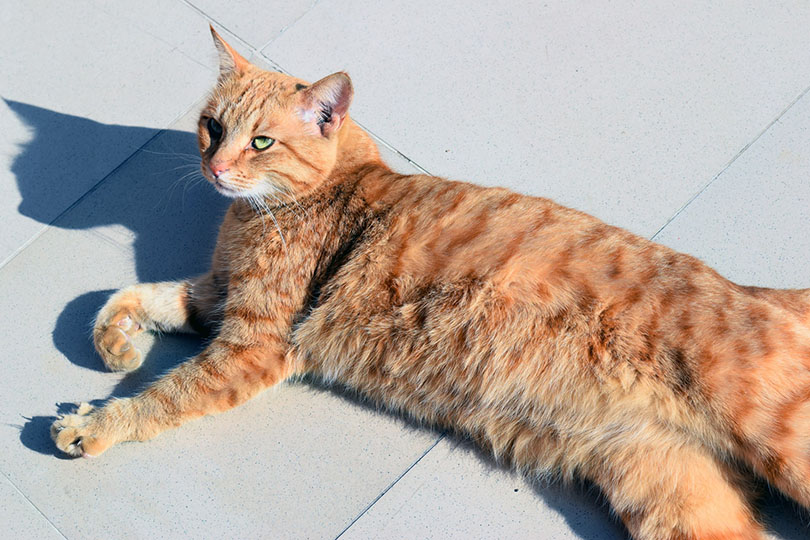
It’s no secret that our cats love basking in warm spots. If you give them a sunny window or a heated vent, they’re in heaven! But we all know that extra hot temperatures aren’t suitable for anyone, including our feline companions.
With summer coming up, you might wonder how hot is too hot for cats—both in terms of scorching surfaces or outdoor weather in general. In short, cats should avoid temperatures exceeding 100° Fahrenheit (38° Celsius).
Here, we will go over all of the ins and outs of temperature ranges for kitties to keep your pal safe and comfortable this season!
Temperatures Too Hot for Kitties
Your kitty will love basking in the heat, but there are limitations. Even though cats are much more heat tolerant than some dog breeds, temperatures exceeding 100° Fahrenheit (38° Celsius) are just too toasty. The heat tolerance for double or triple-coat cat breeds is lower, as they’re typically not accustomed to such warm temperatures.
So if you know that the weather will be extra spicy that day, your cats should stay in a well-ventilated, cool area. The best fix for a hot day is to keep your cat indoors. For cats that love to venture outdoors, you should walk your cats on a leash or let them out into their “catio” outside of peak temperatures (dawn and dusk are the best times for catio visits).
When offered a choice, cats will naturally opt for places with a comfortable temperature (much like how we prefer cold rooms on a hot day). So if you live in a very hot area, your cat will find a cooler place to stay comfortable.
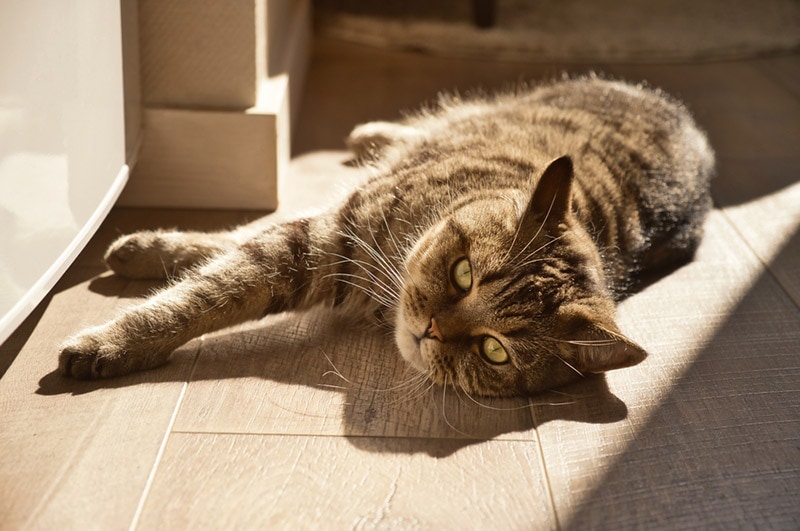
How Do Cats Cool Themselves?
We all know that dogs pant to regulate their body temperature. But how about cats? After all, you rarely see a cat walking around panting and drooling like our canine comrades. Most of the time, they find a cooler place to hang out.
What you might notice instead is an influx in grooming. To cool down, your cat licks their coat, providing a cooling effect as it evaporates. They also have sweat glands in their paws that offer a moderate amount of temperature control.
If it is excessively hot, your cat might resort to panting. Like dogs, this allows the saliva to evaporate from the tongue, cooling them down. However, this isn’t normal and might indicate your cat is overheating. Immediately move your cat to a cool area and offer them water if you notice this. Arrange a visit with your veterinarian as well, as heat stroke is very dangerous for cats.
If you find your cat has their mouth open on a not-so-hot day and with no signs of stress, it might not be due to overheating. So, it would help if you learned to distinguish being too hot from a Flehmen response.
What Is a Flehmen Response?
The Flehmen response also requires your cat’s mouth to be open, but it’s for a completely different reason. The cat uses a combination of senses, taste and smell, to get a better indication of what’s going on in its surroundings.
Your cat will open their mouth, almost grimacing by curling their upper lip to scan the scent past its vomeronasal organ. It is a significant part of their sensory system. Males tend to display the flame in response more than females, primarily due to seeking a mate.
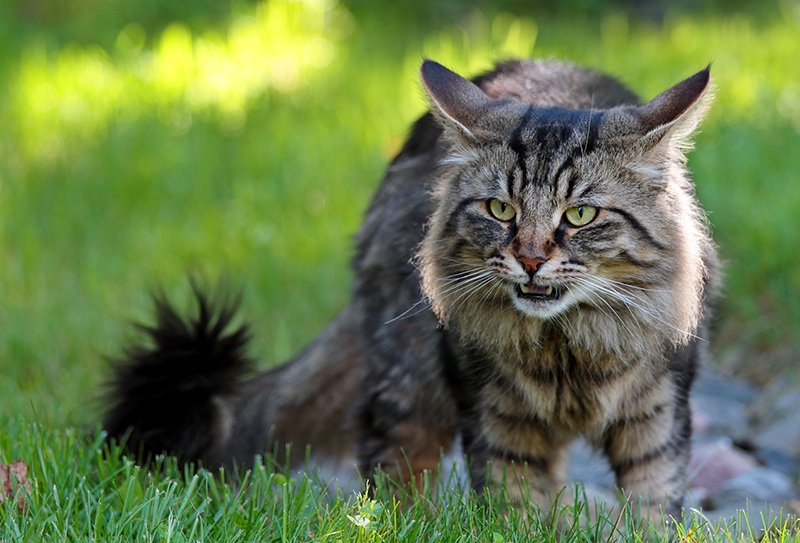
When Heat Becomes a Problem
If your cat is exposed to temperatures that are too hot for too long, it can result in a heat stroke. Heat stroke can cause some serious complications, including major organ damage and even death. So if you suspect heat stroke in your cat, it’s imperative to get them the care that they need immediately.
- Glazed eyes
- Loss of balance
- Lethargy
- Rapid heart rate
- Wobbling
- Vomiting
- Seizures
- Redness on gums and tongue
- Collapse
Some cats can have a higher risk for heat stroke. Some cats can have a higher risk for heat stroke. Cats at more of a risk include those that are very young or very old, those that have a double or triple coat, are overweight, or brachycephalic (an example of a brachycephalic cat would be a Persian). If your cat falls under one of these categories, it is best to keep them indoors on muggy, humid, or hot days.
Hydration Is Crucial
Since being hot causes your cat to lose a lot of moisture, hydration is absolutely vital in hot months. Proper hydration helps with temperature regulation, electrolyte maintenance, digestion, joint lubrication, and oxygen delivery.
Since cats often don’t drink enough water as is, they might need a little help staying hydrated in the summertime. The general rule is that cats must consume about 4 ounces of water per 5 pounds of body weight. That means a cat weighing roughly 10 pounds needs a whole cup of water daily.
Feeding your cat wet food can boost hydration, which can be hard to do on a dry food diet. If you don’t want to purchase wet canned cat food, you can always soak their dry kibble in a little water to provide a more appetizing hydration source. Alternatively, you may try a cat-safe gravy-based food topper for your cat’s kibbles. Cats are inquisitive and may enjoy investigating a pet water fountain more than a plain water bowl.
Water fountains can really help your cat drink more water, but finding the right one can be a challenge. Our Hepper Stainless Steel Cat Water Fountain will keep your cat safe and hydrated with its advanced triple filtration system and large capacity. It's easy to clean in the dishwasher and offers three different flow modes and an automatic shutoff.
- Premium 304-Grade Stainless Steel - This metal cat water fountain is hygienic, with superior...
- Serene & Healthy Cat Drinking Fountain Experience - With whisper-quiet pumping & an advanced...
Signs of Dehydration
If your cat is not getting enough water in their daily diet during hot months, it can quickly cause dehydration.
- Lethargy
- Poor appetite
- A slow skin tent recoil (on a skin tent pinch test)
- Dry mucous membranes
- Sunken eyes
- Weakness
While dehydration can happen if your cat’s diet isn’t properly maintained, it can also be a sign of underlying illness. So if you find that dehydration is becoming a problem for your cat, it’s for the best that you get them into the vet as quickly as possible.
For the safety and livelihood of your kitty, it’s best always to get ahead of any developing health issues. Your vet will screen them for underlying health issues that could contribute to the problem. Cats with these issues are more susceptible to hot temperatures, as it dries them out even further.
Watch Paw Pads
Even if you think it’s totally safe for your cat to be outside, remember to watch their paw pads. Pavement and other heat-retaining surfaces can get extremely hot in direct sunlight which could result in burning and blistering.
If the temperature is over 85°Fahrenheit (29°C), it can cause the pavement, cement, or gravel to get scorching hot. So anytime it is above those temperatures, you should always take extra precautions if your cat plans to be outside for any length of time.
If your cat’s paws look swollen, red, or blistery, it is imperative to seek medical attention immediately. These burns can result in infection, which can get quite serious. So always give your cat a quick look over if they spent some time outside in the heat.
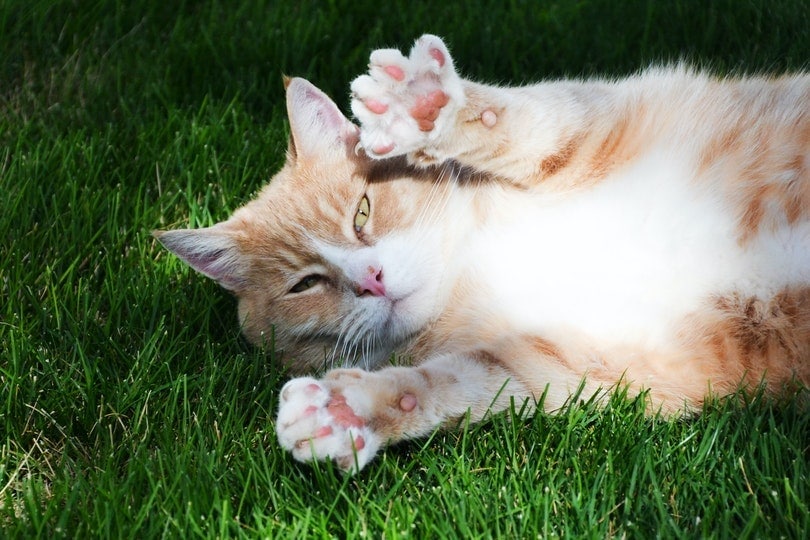
Do Not Leave Your Cat in the Car
You might not take your count on many outings, but it’s imperative not to do so on hot days. Even if the weather outside feels pretty temperate, it can get twice as hot in your cat, even with the windows slightly cracked.
Realistically, it would be best if you didn’t even leave your cat in the car any time it’s over 60 degrees outside. So, that completely takes out most summer months. The only time your cat should be in the car is if they have another person with them with the air conditioner on.
However, they should always be supervised by others for any length of time spent in the car.
When Should Cats Go Outside?
It’s best to keep your cats indoors as much as possible in the summer months. This helps protect your cat from excessive overheating and ensure its tootsies stay in good condition. However, if your cat insists on going out, it’s best to walk them or allow access to a catio in the early morning hours or evening hours. Letting cats roam unsupervised is not advised, as it may be dangerous for your cat and the local fauna where you live.
Try to avoid the hottest parts of the day, which is between noon and 3 p.m. Temperatures start to cool off as the sun starts to set. So, in the peak of summer, bring your cat in before 11 a.m. and out again after roughly 5:30 p.m. on suitable days.
Any day over 100°F (37.7°C), keep them indoors in a cool environment. Always use your best judgment and remember to check the weather before opening your doors to let them roam freely.
Conclusion
Cats are not impervious to the effects of high temperatures. Temperatures over 85°F (29.4°C) can result in burnt paw pads, which is something you want to avoid. If your cat is outside and temperatures are over 100°F (37.7°C), it can result in some severe health complications, including heat stroke.
Ultimately, it’s best to keep your cat indoors in the summer months as much as possible. If you let them outside, it’s best to avoid the hottest parts of the day, allowing them to partake in supervised exploration in the morning and evening hours instead.
Featured Image Credit: Safoora Taimoor, Unsplash



